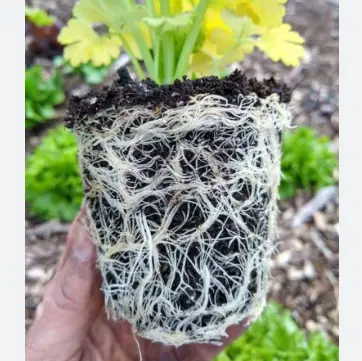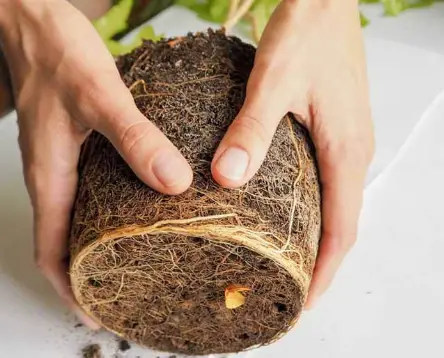Root balls are a root system of plants that they form growing up. Now, if your plant is not well or dying, then you may have forgotten to loosen the root ball.
So, what happens if you forgot to loosen the root ball?
It’s necessary to loosen the root ball before planting to ensure a plant’s healthy growth. Forgetting to do so can negatively impact the plant’s establishment and overall health. However, if you find yourself in a situation you should gently separate the soil around the root ball. Also, you can separate the roots by hand and even soaking the root ball in water can help.
To have the proper knowledge about this, go through the whole article.
What Can Happen if You Forgot to Loosen the Root Ball?
Forgetting to loosen the root ball before planting can negatively impact a plant’s growth and health. The roots may struggle to establish new roots, leading to stunted growth or even death in severe cases.
However, in most cases, if you forgot to loosen the root ball, most plants will likely be fine. Also, some plants may even benefit from undisturbed roots.

Now, if the root ball is damaged during a transplant, the plant may never fully recover. When transplanting plants with large root balls, it’s essential to handle the root ball delicately.
When removing a plant from a container, be careful to protect the fragile root ball. This ensures the plant’s healthy establishment in its new location.
Why Is It Important to Loosen the Root Ball?
Because it enables the roots to spread out and establish a strong foundation in the new soil. When the root ball is loosened, it allows the roots for healthy growth by exploring the surrounding soil.
If the root ball is not loosened before transplanting, the roots may remain tightly packed and restricted. As a result, the plant may experience stunted growth and have poor overall health.
Plants can even face the risk of death, particularly in severe cases. But some vegetable plants grow well on rocky soil where you don’t need to be aware of root balls.
By loosening the root ball, the plant has a greater chance of successfully adapting to its new environment. It establishes a robust root system, which is essential for its long-term growth and survival.
How to Loosen a Root Ball Before Planting?
If you haven’t loosened the root ball already, it’s not too late. Here’s how to loosen a plant’s root ball when planting or transplanting.
Tools Needed:
- Garden fork
- Pruning shears (if necessary)
Here are some steps for planting a plant while loosening the root ball delicately:
- Water the plant thoroughly a day or two before transplanting to ensure the soil holds together.
- Dig a hole in the new planting location that is slightly larger than the root ball.
- Carefully remove the plant from its current container or location, being cautious not to damage the roots.
- Use a garden fork to gently loosen the soil around the root ball. Take great care to avoid damaging the roots.
- If the roots are tightly bound or circling, use pruning shears to make a few cuts through the roots. This’ll promote new growth and prevent potential root girdling.
- Plant in the new hole and backfill with soil, pressing down gently to eliminate air pockets.
- Water the plant thoroughly to help settle the soil around the roots and ensure proper hydration.
Remember, treating the root ball with care during the transplanting process is essential to prevent root damage. And always ensure the plant’s overall health and vitality.
What to Do Next if You Forgot to Loosen the Root Ball?
If you forgot to loosen the root ball before planting, there’re actions you can take to assist your plant.
- First, gently manipulate the soil around the root ball using your hands to loosen it.

- Attempt to carefully separate the roots by hand or by using a garden fork to loosen them.
- Immerse the entire root ball in water for a few hours or overnight if the roots are tightly entwined. This can aid in keeping the roots apart, making it easier to gently separate them manually.
- The roots may need to be lightly trimmed if they have become excessively long.
It’s important to note that most plants will generally be unaffected in the ground without loosening the root ball. However, if your plant was tightly bound in a container or is displaying signs of stress, it needs attention.
It is recommended to loosen the roots before planting to prevent issues like circling roots or inhibited growth.
How to Determine If You’ve Loosened the Root Ball Enough?
To determine if you have adequately loosened the root ball, consider the following indicators:
- Assess the extent of disturbed fibrous roots. If you observe a noticeable number of loosened roots, you are likely making progress.
- In the case of repotting, examine the shape of the root ball. Circular roots around the root ball indicate that the plant is root-bound and needs to be loosened.
- The soil seems no longer compacted and the root’s starting to spread.
- If the plant becomes easier to remove, then you’ve loosened the root ball enough.
- If the root is not loosened enough it can show symptoms like yellow or faded leaves. In this case, you can lose the roots. You can also get a cure for your pride of Barbados plant’s yellow leaves problem in such ways.
It’s crucial to exercise caution and prioritize gentleness when loosening the root ball. Aggressive handling can potentially damage the roots and subject the plant to stress.
Tips to Avoid this Mistake Further
To ensure you don’t forget to loosen the root ball, consider the following tips:
- Include “loosen root ball” in your checklist and mark it off once you have completed the task.
- Research the specific type of plant you’re bringing home to familiarize yourself. Consider any special instructions or requirements for maintaining its health.
- Allow your plant some time to acclimate to its new environment before attempting to transplant it. This period of adjustment gives the roots more opportunity to adapt and makes the transplanting process smoother.
The root ball of most plants can survive without loosening. But loosening it correctly can add to the strength of the plant.
Frequently Asked Questions (FAQs):
Are Thick Roots Good?
Yes, Thick roots are good for plants. Thicker roots have the advantage of being able to absorb larger quantities of nutrients at once. It allows the plant to uptake more essential elements for its growth and development.
How Long Should You Let Roots Sit?
You should let your plant’s root sit for 2 to 4 inches. It’s generally recommended that roots have developed to a length of at least two to four inches before transplanting. Longer roots are better equipped to anchor the plant securely in the soil and provide stability.
What Makes Roots Stronger?
Adequate watering makes the root of a plant stronger. In the initial weeks after planting, daily watering is recommended to ensure that the root ball remains consistently moist.
Conclusion
Now you know what to do when you forgot to loosen the root ball.
Although it’s important to remember to loosen the root ball before planting. If you’ve forgotten to loosen the root ball before planting, act before worrying. There are still some actions you can take to support the plant’s well-being.
- Why Are There Still No Tomatoes in My Tomato Plants? Let’s Fix the Issue! - July 13, 2023
- Water Propagation White Stuff on Roots: Everything You Should Know! - July 11, 2023
- String of Dolphins Drying Up: Solved! - July 11, 2023
